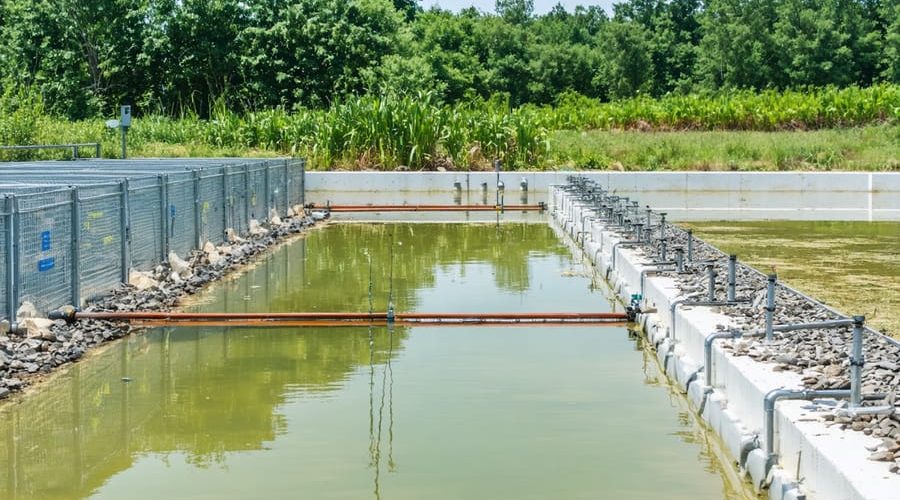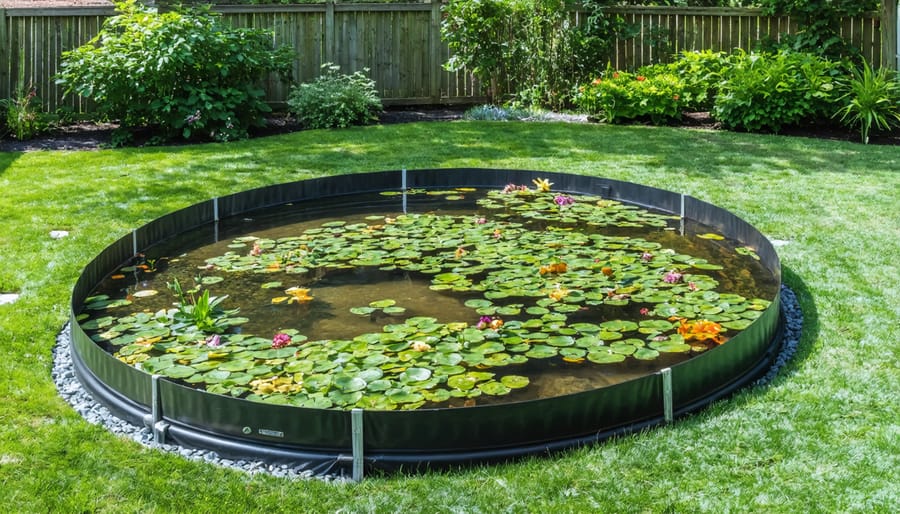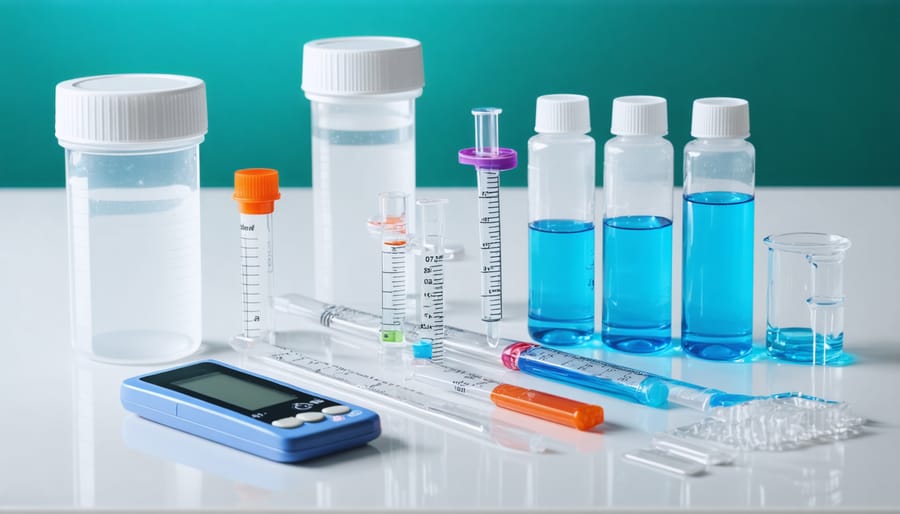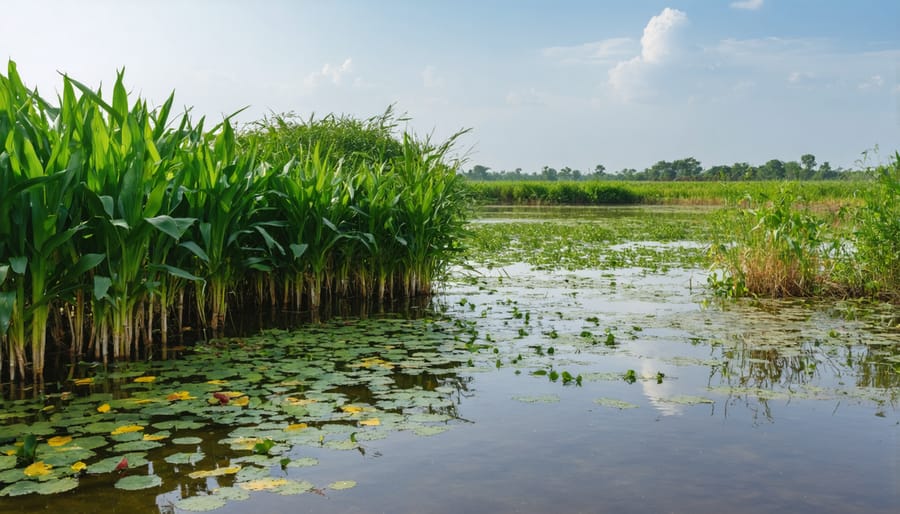
Keep Your Fish Safe: Essential Guide to Containment Pond Safety and Metal Testing
Containment ponds serve as crucial defense systems against environmental contamination, protecting groundwater and surrounding ecosystems from potentially harmful substances. These engineered basins play a vital role in industrial, agricultural, and mining operations by safely storing and treating contaminated water, chemicals, and waste materials. Regular monitoring pond chemistry ensures these structures maintain their integrity and effectiveness.
Beyond basic water storage, containment ponds incorporate sophisticated liner systems, leak detection equipment, and treatment processes to manage everything from storm runoff to industrial wastewater. Their design must account for local rainfall patterns, soil conditions, and potential emergencies while meeting strict environmental regulations.
For property owners and facility managers, understanding containment pond maintenance isn’t just about compliance—it’s about protecting valuable resources and preventing costly environmental incidents. Regular inspections, proper liner maintenance, and strategic water level management form the foundation of effective containment pond operation, ensuring these essential structures continue serving their protective purpose for years to come.
Understanding Containment Ponds in Your Water Garden
Types of Containment Systems
Containment ponds come in various designs, each tailored to specific needs and purposes. The most common type is the earthen pond, which is created by excavating natural soil and often lined with clay or synthetic materials. These are popular for stormwater management and agricultural use due to their cost-effectiveness and natural appearance.
Concrete-lined ponds offer superior durability and are typically used in industrial settings where chemical resistance is crucial. Their solid construction prevents seepage and provides excellent containment for potentially hazardous materials.
HDPE-lined (High-Density Polyethylene) ponds feature a flexible synthetic liner that’s both chemical-resistant and UV-stable. These are versatile options suitable for various applications, from mining operations to wastewater treatment.
Double-lined containment systems incorporate two layers of liner material with a leak detection system between them. This advanced design is used in high-risk applications where environmental protection is paramount.
Modular containment ponds, made from prefabricated sections, offer quick installation and portability. These are ideal for temporary projects or sites with limited space, providing flexibility without compromising containment effectiveness.
Natural vs. Artificial Containment
When creating a water garden, you’ll face a choice between natural and artificial containment methods. Natural containment relies on existing landscape features and clay-rich soil to create a more organic-looking pond that seamlessly blends with its surroundings. These ponds often incorporate natural water circulation systems and require minimal artificial materials.
Artificial containment, on the other hand, typically uses manufactured liners or pre-formed shells. While these might seem less natural, they offer excellent water retention and are ideal for areas with sandy or porous soil. They’re also more predictable in terms of maintenance and often easier to install for DIY enthusiasts.
Both approaches have their merits. Natural containment creates a more authentic ecosystem but may require more initial planning and soil testing. Artificial containment provides better control over the pond’s shape and depth but might need more attention to disguise edges and create a natural appearance. Consider your landscape, soil type, and maintenance preferences when choosing between these options.

Common Heavy Metal Contaminants
How Heavy Metals Enter Your Pond
Heavy metals can sneak into your pond through various sources, and being aware of these entry points is the first step in preventing contamination. The most common sources include rainwater runoff from nearby roads or buildings, which can carry traces of metals from vehicle emissions and building materials. Garden fertilizers and pesticides can also introduce unwanted metals into your pond system.
Natural soil erosion around your pond might contribute to metal accumulation, especially in areas with mineral-rich soil. Old plumbing systems or metal decorative features in your pond can slowly release metals as they deteriorate over time. Even falling leaves from trees growing in contaminated soil can introduce heavy metals when they decompose in your pond.
To protect your pond, consider installing proper drainage systems to redirect potentially contaminated runoff away from your pond. Using natural barriers like rocks or plants around the pond’s edge can help filter water before it enters. It’s also wise to avoid using metal-based products near your pond and opt for pond-safe materials when adding decorative elements.
Regular maintenance plays a crucial role too. Remove fallen leaves promptly, and consider testing your water quality regularly. If you live in an area with high industrial activity or near busy roads, you might want to install additional filtration systems specifically designed to remove heavy metals.
Signs of Metal Contamination
Keeping an eye out for signs of metal contamination in your containment pond can help you catch problems early. The most noticeable indicator is often unusual water coloration – watch for bluish-green tints, which might suggest copper presence, or rusty orange hues that could indicate iron contamination.
Your pond life can also tell you a lot about potential metal issues. Fish may become less active or show unusual swimming patterns, while you might notice fewer frogs or insects around the pond than usual. Look for signs of stress in your fish, such as rapid gill movement or them gasping at the surface more frequently than normal.
Plant life offers additional clues – keep an eye out for yellowing leaves, stunted growth, or plants that simply aren’t thriving despite good care. Some plants might develop brown spots or show signs of wilting even when well-watered.
The pond’s ecosystem might also give you hints through algae behavior. Excessive algae growth or sudden algae die-offs can indicate metal imbalances. Pay attention to any unusual films or sheens on the water’s surface, particularly after rainfall.
If you notice any of these signs, it’s important to test your water quality right away. Remember that early detection and quick action are key to maintaining a healthy pond environment for all your aquatic friends.
DIY Testing and Monitoring
Essential Testing Equipment
Keeping your containment pond safe starts with having the right testing equipment on hand. A comprehensive water testing kit is your most valuable tool, and should include tests for pH, dissolved oxygen, and metal content. Look for a kit that can detect common metals like copper, iron, and zinc – these are often the usual suspects in pond contamination.
A digital pH meter provides more accurate readings than test strips and is worth the investment. You’ll also want a turbidity meter to measure water clarity, as murky water can indicate potential metal contamination. Don’t forget about temperature monitoring – a reliable floating thermometer helps track conditions that might affect metal concentrations.
For serious monitoring, consider getting a portable spectrophotometer. While it’s pricier than basic testing tools, it gives precise readings of metal levels. If you’re on a budget, multi-parameter test strips can serve as a good starting point, though they’re less accurate than electronic devices.
Keep your testing supplies in a waterproof container near your pond, and always have spare reagents and calibration solutions ready. Remember to check expiration dates on your testing materials – expired tests can give false readings and compromise your pond’s safety.

Testing Schedule and Procedures
Regular testing of your containment pond is crucial for maintaining a healthy ecosystem. We recommend following these essential water quality testing methods on a consistent schedule:
Weekly Tests:
• Check pH levels (aim for 6.5-8.5)
• Monitor water temperature
• Test ammonia levels
• Measure dissolved oxygen
Monthly Tests:
• Nitrate and nitrite levels
• Phosphate concentration
• Algae presence
• Sediment accumulation
Seasonal Tests (Spring/Fall):
• Heavy metal screening
• Bacterial count
• Total dissolved solids
• Contamination indicators
For best results, conduct tests at the same time of day, preferably in the morning. Use clean testing equipment and follow manufacturer instructions carefully. Keep a logbook to track changes over time – this helps identify patterns and potential issues before they become serious problems.
Remember to test more frequently during extreme weather conditions or after adding new plants or fish. If you notice any sudden changes in water quality, increase testing frequency until parameters stabilize. Don’t forget to check the pond’s physical condition during testing, looking for liner damage or debris accumulation that might affect water quality.
Natural Solutions for Metal Control
Plant-Based Solutions
Nature offers some amazing solutions for filtering heavy metals from containment ponds, and certain plants are particularly good at this job! These helpful plants, often called phytoremediators, act like natural water filters by absorbing metals through their roots and storing them in their tissues.
Water hyacinths are superstar metal absorbers, quickly removing copper, zinc, and other metals from pond water. Just be careful – they can grow quite enthusiastically! Cattails are another excellent choice, naturally filtering out harmful substances while adding visual interest to your pond’s edges.
Duckweed, those tiny floating plants, might look humble but they’re mighty effective at soaking up metals. Plus, they’re easy to maintain and control. Water lilies not only add beautiful blooms to your pond but also help remove metals through their extensive root systems.
Reed plants, especially common reed (Phragmites), are particularly good at cleaning up contaminated water. They’re tough, adaptable, and create natural habitats for wildlife too.
Remember to harvest these plants periodically to remove the absorbed metals from your pond system. You can add them to your compost pile, as long as metal levels aren’t too high. It’s nature’s own recycling system at work!

Biological Filtration Methods
Biological filtration harnesses nature’s own cleaning power to keep your containment pond healthy and balanced. At the heart of these natural filtration systems are beneficial bacteria that break down waste and maintain water quality.
These helpful microorganisms colonize various surfaces in your pond, particularly in areas with good water flow. They’re especially fond of filter media, plant roots, and rocks. As water passes through these bacterial colonies, they convert harmful ammonia from fish waste into less toxic substances through a process called nitrification.
You can encourage biological filtration by adding features like waterfall filters, submersible filters, or dedicated bio-filters filled with special media. Plant life also plays a crucial role – water lilies, cattails, and other aquatic plants naturally filter water while providing shelter for beneficial bacteria.
To keep your biological filtration working effectively, avoid using harsh chemicals that might harm the good bacteria. Regular maintenance, like gentle cleaning of filter media with pond water (not tap water), helps preserve these valuable bacterial colonies while removing excess debris.
In wrapping up our discussion on containment ponds, it’s clear that these essential water management systems require consistent attention and care to function effectively. Regular monitoring isn’t just a recommendation – it’s a crucial practice that helps prevent potential issues before they become serious problems. By staying vigilant with water quality tests, checking liner integrity, and maintaining proper water levels, you can ensure your containment pond continues to serve its purpose effectively.
Remember that successful pond management is an ongoing process. Weekly visual inspections, monthly water quality checks, and seasonal maintenance tasks create a solid foundation for long-term pond health. Don’t forget to keep detailed records of your monitoring results, which can help you spot trends and address emerging concerns early.
The investment in proper monitoring equipment and regular testing may seem substantial initially, but it’s far more cost-effective than dealing with major repairs or environmental issues down the line. Whether you’re managing a small decorative pond or a large industrial containment system, these monitoring practices are your best defense against potential problems.
By following the guidelines we’ve discussed throughout this article, you’ll be well-equipped to maintain a healthy, functional containment pond that meets both aesthetic and practical needs. Remember, a well-maintained containment pond isn’t just about compliance – it’s about creating a sustainable water management solution that benefits both your property and the environment.
